Observing microstructure evolution inside of bulk materials
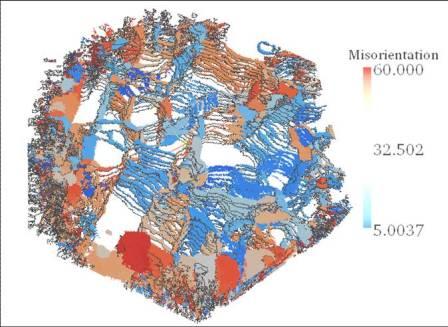 |
Carnegie Mellon
|
| High Energy X-ray Diffraction Microscopy
(HEDM): Observing microstructure evolution inside of bulk materials
Grain growth in high purity
aluminum measured with HEDM at the Advanced Photon Source (S.F.
Li, C.M. Hefferan, U. Lienert,
R.M. Suter,
unpublished): Colors
are
mapped
from
three
crystallographic
misorientation parameters
calculated on a voxel-to-voxel basis between an initial measured state
and an annealed state. Only misorientations greater than 5 degrees are
plotted so as to show the motion of large angle grain boundaries under
annealing. Hexagon indicates simulated region used in
reconstruction.
|
||
Table
of
Contents (modified October 2009)
Related Publications
Probing
Microstructure
Dynamics
With
X-ray
Diffraction Microscopy, R.M.
Suter, C.M. Hefferan, S.F. Li, D. Hennessy, C. Xiao, U.
Lienert,
B. Tieman, J. Eng. Mater. Technol., 130, 021007 (2008); proceedings of
the Materials Processing
Defects-5
conference, Cornell University, July 2007).
3-Dimensional Characterization of Polycrystalline Bulk Materials Using High-Energy Synchrotron Radiation, U. Lienert, J. Almer, B. Jakobsen, W. Pantleon, H.F. Poulsen, D. Hennessy, C. Xiao, and R.M. Suter, Materials Science Forum 539-543, 2353-2358 (2007).
Tracking: a method for structural characterization of grains in powders or polycrystals, E.M. Laurdisen, S. Schmidt, R.M. Suter, and H.F. Poulsen, J. Appl. Cryst., 34, 744-750 (2001).
Three-dimensional maps of grain boundaries and the stess state of individual grains in polycrystals and powders, H.F. Poulsen, S.F. Nielsen, E.M. Laurdisen, S. Schmidt, R.M. Suter, U. Lienert, L. Margulies, T. Lorentzen, and D. Juul Jensen, J. Appl. Cryst., 34, 751-756 (2001).
Some examples of microstructure
measurements using x-ray diffraction microscopy
All data shown here
were collected at the Advanced Photon Source, beamline 1-ID at Argonne
National Laboratory. Participants include Chris Hefferan, Frankie Li,
Robert Suter (CMU) and Ulrich Lienert (APS). Important computational
assistance was provided by Brian Tieman of the APS; analysis was
performed using custom software developed at CMU running on a 68 node
cluster at the APS.
Questions or
comments? e-mail:
suter@andrew.cmu.edu
1. A section through the middle of a NIST certified 152
micron diameter single crystal ruby sphere. a) The color map on
the left shows misorientations from the average orientation.
Red-green-blue color contributions are proportional to the Rodrigues
vector describing the misorientation.
The maximum rotation angle is 0.3 degrees.
The green circle shows the nominal 152 micron sample cross-section
while the hexagon shows the entire region included in the analysis. The
maximum radial deviations are roughly 8 microns. b) The map on the
right shows the 'confidence' fitting paramter indicating maximal
overlap of the simulation with the experimental data in the central
region and reduced overlap near the edges. This reduction is due to
background subtraction removing weak edges of the imaged diffraction
spots. This fit is based on simulation of 1118 ruby Bragg peaks about
115 of which could be observed at more than one detector distance in
the experimental data set. A confidence of 0.79 means that over 90
simulated peaks overlap experimentally observed peaks; 0.33 confidence
implies 38 overlaps.
 |
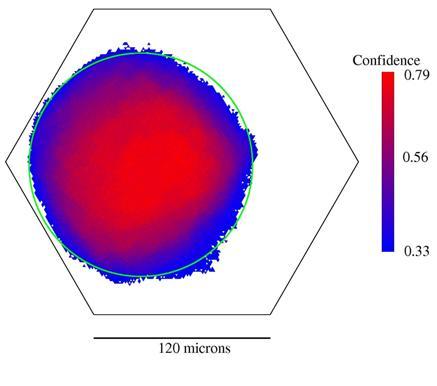 |
| Ruby sphere orientation map (expanded scale) |
Relative confidence map for image at left |
2. Near surface sections through an aluminum 1050 alloy
polycrystal sample. Colors indicate grain orientations,
again coded by Rodrigues vector components. The blue circle indicates
the 1 mm nominal sample diameter while the hexagon is the analysis box.
Black lines in the maps are draw between elements with more than 5
degree misorientation.
| z =
0 |
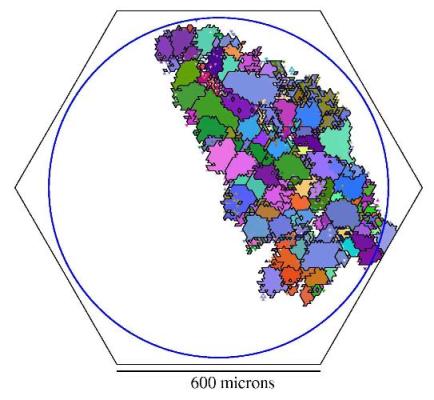 |
| z = -10um |  |
| Point-to-point crystallographic
misorientation between the above two layer measurements. Black lines
show boundaries in the z = 0 layer. |
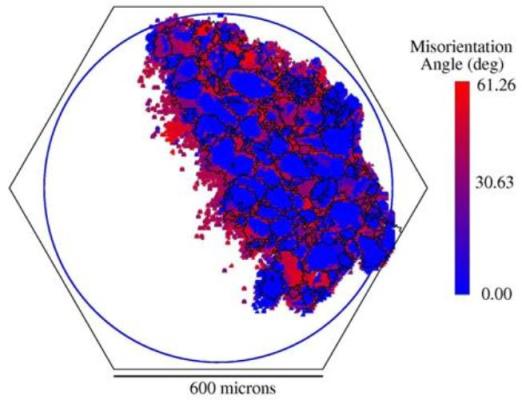 |
Overview of relevance of HEDM microstructure mapping
techniuqe
Polycrystals are aggregates of single crystals joined together by a network of internal interfaces called grain boundaries. Polycrystalline materials, in both single and multi-phase forms, are ubiquitous in engineered systems: integrated circuits, aircraft and automotive components, communications devices, machine tools, and many others. The three dimensional geometry, arrangement, and relative orientation of the grains and the consequent grain boundary network (i.e., the microstructure) are crucial determinants of mechanical, chemical, thermal, and electrical properties. While there has been dramatic progress made in gaining three dimensional information about microstructure from two dimensional measurements made at surfaces (CMU MRSEC), it remains a great challenge to be able to watch microstructural evolution in response to external stimuli. With such observations made deep inside bulk materials, we should be able to deepen our understanding of phenomena and develop accurate constitutive relations governing the evolution and thereby learn how to do predictive calculations and to tailor microstructures to specific applications.
Three Dimensional X-ray Diffraction Microscopy (see articles listed above and the monograph by H.F. Poulsen, "Three Dimensional X-ray Diffraction Microscopy," Springer, 2004) is the only method available that can non-destructively image macroscopic volumes of internal microstructures. Based simply on Bragg diffraction, it is as versatile as, for example, electron backscatter diffraction analysis of surface microstructures. But by using high energy x-rays, it looks through millimeters of material without the need for destructive serial sectioning. Similar to serial sectioning work, measurements are done layer-by-layer. After the measurement, the sample still exists and can be re-measured after processing. Real-time dynamics can be monitored. The x-rays can penetrate sample chambers, making in-situ measurements possible. In sum, high energy x-ray diffraction microscopy (HEDM) promises to open the world of microstructure dynamics and response to a new light. In combination with powerful new computational tools, one can look forward to a new level of understanding and a new level of "dynamic three dimensional command over materials structure," (ONR BAA 04-024) processing, and properties.
Schematic and Outline of the Technique
 |
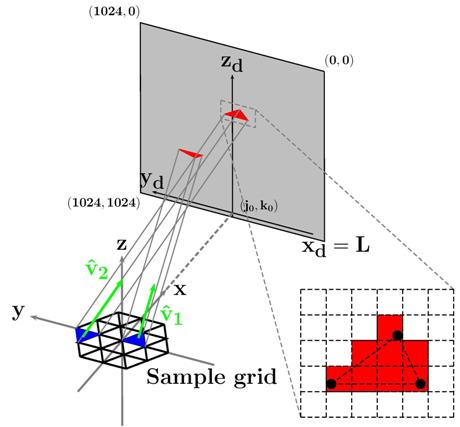 |
Apparatus at APS beamline XOR-1
The following images were taken during our
January 2008 beam time:
various updates (such as new CCD cameras) have occurred since then.
Sample
stage
at
1-IDB.
|
|
| Frankie and Chris at 1-ID command central |